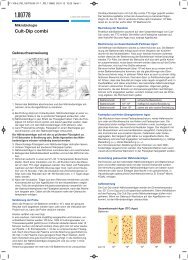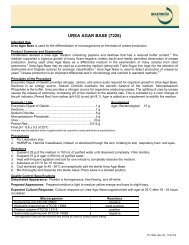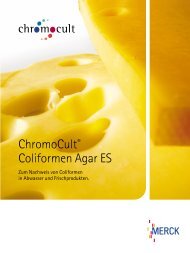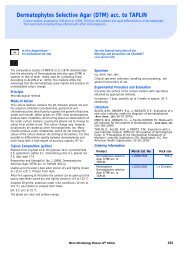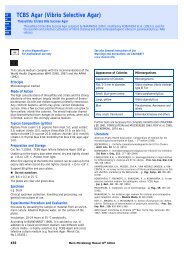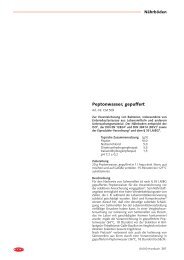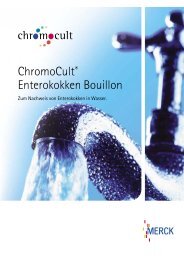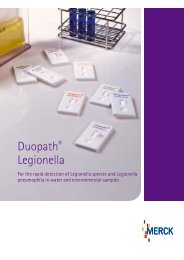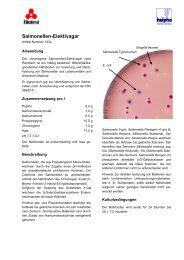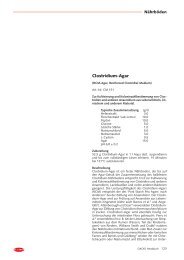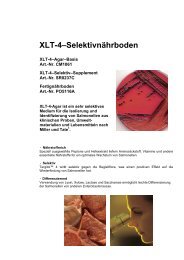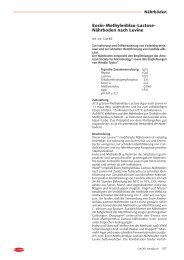DHL Agar acc. To SAKAZAKI - mibius
DHL Agar acc. To SAKAZAKI - mibius
DHL Agar acc. To SAKAZAKI - mibius
You also want an ePaper? Increase the reach of your titles
YUMPU automatically turns print PDFs into web optimized ePapers that Google loves.
<strong>DHL</strong> <strong>Agar</strong> <strong>acc</strong>. <strong>To</strong> <strong>SAKAZAKI</strong><br />
Deoxycholate hydrogen sulfide lactose agar is used for the detection and isolation of pathogenic Enterobacteriaceae<br />
from all types of materials.<br />
<strong>DHL</strong> <strong>Agar</strong> <strong>acc</strong>. <strong>To</strong> <strong>SAKAZAKI</strong><br />
in vitro diagnosticum –<br />
For professional use only<br />
See also General Instruction of Use<br />
Warnings and precautions see ChemDAT®<br />
(www.chemdat.info)<br />
This medium represents a modified deoxycholate agar as<br />
proposed by <strong>SAKAZAKI</strong> et al. (1960, 1971).<br />
Principle<br />
Microbiological method.<br />
Mode of Action<br />
H 2 S production is indicated by a blackening of the colonies due<br />
to formation of iron sulfide. Although Proteus is H 2 -positive, its<br />
colonies are not black. Colonies of Proteus, Morganella,<br />
Rettgerella and Providencia are, however, surrounded by dark<br />
brown zones, which occur, because these species act on the<br />
phenylalanine of the peptone to produce phenylpyruvate, which<br />
forms an iron complex with iron(III) ions. The sucrose content of<br />
the medium permits differentiation of weakly lactose-positive or<br />
lactose-negative, sucrose-positive species from sucrose- and<br />
lactose-negative Enterobacteriaceae. The deoxycholate largely<br />
suppresses the growth of Gram-positive bacteria and prevents<br />
the swarming of Proteus species. This medium provides a rich<br />
nutrient base and contains a relatively low concentration of the<br />
inhibitor deoxycholate. These properties permit growth of even<br />
fastidious strains of Salmonella and Shigella. The colonies<br />
formed are considerably larger than those found on other<br />
selective culture media. Proteus, Morganella, Rettgerella and<br />
Providencia can be differentiated from Salmonella.<br />
Typical Composition (g/litre)<br />
Peptone from casein 10.0; peptone from meat 10.0; meat extract<br />
3.0; lactose 10.0; sucrose 10.0; L-cysteinium chloride 0.2;<br />
sodium citrate 1.0; sodium deoxycholate 1.5; sodium thiosulfate<br />
2.0; ammonium iron(III) citrate 1.0; neutral red 0.03; agar-agar<br />
15.0.<br />
Preparation and Storage<br />
Usable up to the expiry date when stored dry and tightly closed<br />
at +15 to +25° C. Protect from light.<br />
After first opening of the bottle the content can be used up to the<br />
expiry date when stored dry and tightly closed at +15 to +25° C.<br />
Suspend 63.5 g/litre, pour plates to give thick layers (about 20ml<br />
per plate).<br />
• Do not autoclave.<br />
pH: 7.2 ± 0.2 at 25 °C.<br />
The plates are clear and red.<br />
Experimental Procedure and Evaluation<br />
Spread the sample or material from an enrichment culture thinly<br />
on the surface of the plates.<br />
Incubation: 24-48 hours at 35 °C aerobically.<br />
Appearance of Colonies<br />
Red surrounded by a zone of<br />
precipitate, medium sized, flat<br />
Pink with a red centre, often<br />
mucoid<br />
Colourless, sometimes with a<br />
black centre<br />
Colourless, surrounded by a<br />
dark brown zone<br />
Red, surrounded by a dark<br />
brown zone<br />
Colourless with a black centre<br />
Colourless, large, flat<br />
Literature<br />
<strong>SAKAZAKI</strong>, R., NAMIOKA, S., OSADA, A., a. YAMADA, C.A.: A problem on<br />
the pathogenic role of Citrobacter of enteric bacteria. - Japan. J. Ex. Med.,<br />
30; 13-22 (1960).<br />
<strong>SAKAZAKI</strong>, R., TAMURA, K., PRESCOTT, L.M., BENZIC, Z., SANYAL, S.C., a.<br />
SINHA, R.: Bacteriological examination of diarrheal stools in Calcutta.<br />
-Indian J. Med. Res., 59; 1025-1034 (1971).<br />
Ordering Information<br />
Microorganisms<br />
Escherichia coli<br />
Enterobacter, Klebsiella and<br />
others<br />
Citrobacter<br />
Proteus mirabilis, Morganella,<br />
Rettgerella, Providencia<br />
Proteus vulgaris<br />
Salmonella (incl. Arizona)<br />
Shigella<br />
Product Merck Cat. No. Pack size<br />
<strong>DHL</strong> <strong>Agar</strong> <strong>acc</strong>. to<br />
<strong>SAKAZAKI</strong><br />
1.11435.0500 500 g<br />
Specimen<br />
e.g. Stool.<br />
Clinical specimen collection, handling and processing, see<br />
general instructions of use.<br />
262 Merck Microbiology Manual 12 th Edition
<strong>DHL</strong> <strong>Agar</strong> <strong>acc</strong>. <strong>To</strong> <strong>SAKAZAKI</strong><br />
Quality control; incubation: 24 h at 35 °C<br />
Test strains Growth Colony colours Black centre Culture Medium<br />
Escherichia coli ATCC 25922 good / very good red - precipitate<br />
Klebsiella pneumoniae ATCC 10031 good / very good pink -<br />
Salmonella typhimurium<br />
ATCC 14028<br />
good / very good colourless + -<br />
Salmonella enteritidis ATCC 13076 good / very good colourless + -<br />
Proteus vulgaris ATCC 13315 fair / good pink - brownish zone<br />
Proteus mirabilis ATCC 14153 good / very good colourless ± brownish zone<br />
Shigella flexneri ATCC 12022 fair / very good colourless - -<br />
Enterococcus faecalis ATCC 11700<br />
Staphylococcus aureus ATCC 25923<br />
Bacillus cereus ATCC 11778<br />
none / poor<br />
none<br />
none<br />
Proteus mirabilis<br />
ATCC 14153<br />
Salmonella enteritidis<br />
ATCC 13076<br />
Merck Microbiology Manual 12 th Edition 263



